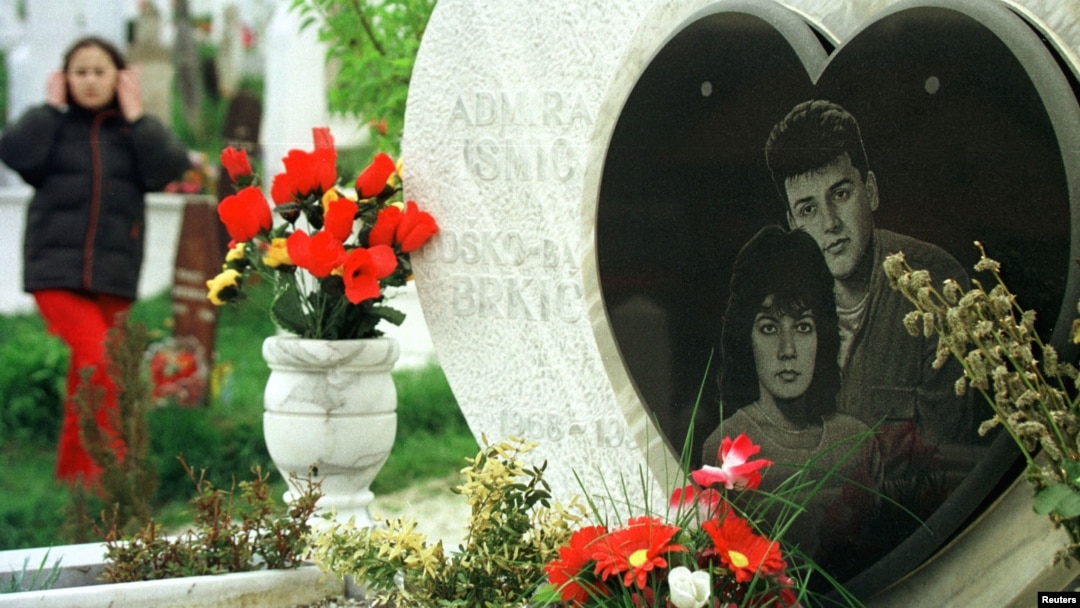A new casualty has emerged from the war that engulfed Bosnia-Herzegovina in the 1990s: ethnically mixed marriages.
Once a shining example of the diversity symbolized by former Yugoslav leader Josip Broz Tito's mantra of "brotherhood and unity," relationships between Muslim Bosniaks, Catholic Croats, and Orthodox Serbs once accounted for about 13 percent of all marriages in Bosnian territory.
But the pressure of living in postwar Bosnia, after 100,000 died during the conflict and another 2 million were displaced, has taken its toll on the country's 3.8 million inhabitants. Today, the number of mixed marriages stands at just 4 percent, according to statistics cited by local media.
"When I take a look at the bigger picture and at the people around us, a lot of people are against it," says Aleksandar Juric, who comes from Gradiska in Republika Srpska, adding that while he's never been in a mixed relationship, he's got no objections to it.
"There are signs that our society is slowly opening up, but considering the entire situation and our politicians,...there won't be any progress on this question."
Tolerance Extinguished
Competing ethnicity has long served to whip up animosities in the Balkans, from the assassination of Archduke Franz Ferdinand that set off World War I over a century ago to the disintegration of Yugoslavia that cost hundreds of thousands of lives in the 1990s.
But before the wars that accompanied Yugoslavia's demise, Bosnia was an exception to the rule. Mixed communities among its population -- 40 percent of which is Muslim, 31 percent Bosnian Serb, and 10 percent Bosnian Croat -- were commonplace.
Some point to the regime of former Yugoslav strongman Slobodan Milosevic as the turning point. Critics accuse Milosevic of whipping up animosity between ethnic groups with nationalist politics to hold onto power and try to keep Yugoslavia intact.
By the time Bosnia unilaterally declared its independence in 1992, animosity had turned to conflict amid a campaign of ethnic cleansing that was punctuated in July 1995 by the massacre of more than 8,000 Muslim men and boys in Srebrenica by units of the Bosnian Serb army of Republika Srpska.
A SREBRENICA TIMELINE
Mirza Emirhafizovic, a lecturer at the Sarajevo Faculty of Political Sciences, says mass migrations after the war have helped redraw Bosnia's ethnic map, stifling the integration of Croats, Serbs, and Bosniaks and pushing mixed marriages to more urbanized areas where ethnic diversity remains.
"The distribution of population caused by the war and the low percentage of returnees is threatening to make this situation permanent. This is creating a low number of social contacts between different groups and leading to a low number of so-called mixed marriages," Emirhafizovic says.
According to a survey by the Pew Center, published in May, only 40 percent of non-Muslim Bosnians would accept Muslims into their family even though almost three-quarters of respondents say a multicultural society is better than a religious and ethnically homogeneous one.
There are similar figures for non-Orthodox or non-Catholic Bosnians who say the same about members of those groups.
In the Balkans, this lack of ethnic acceptance "is most pronounced in Bosnia, despite the fact that it has the most religiously diverse population and the highest percentage in favor of a multicultural society," according to the survey's authors, Scott Gardner and Jonathan Evans.
Killed In Sarajevo
Before the war, Sarajevo was the epicenter of mixed marriages at an estimated 34 percent.
Gunned down by snipers' bullets on a bridge in Sarajevo in May 1993, their bodies entwined in death's grip, Admira Ismic and Bosko Brkic came to symbolize what once was.
Their story was first brought to light by journalist Kurt Schork in a Reuters report before being immortalized as "Romeo and Juliet in Sarajevo" in an award-winning Frontline documentary broadcast in 1994.
Bosko, a 24-year-old ethnic Serb, was killed instantly as the couple made a desperate dash across the Vrbanja Bridge toward freedom and safety. Seconds later, Admira, his 25-year-old Bosniak girlfriend, was gravely wounded as well. She crawled to Bosko and, after about 10 minutes, died at his side.
The bodies remained in the no-man's land of besieged Sarajevo for nearly four days before Serbian forces surrounding the city sent some Muslim prisoners to gather them.
"Difficult times always bring great romance. They were not from the same tribe, they did not have the same god, but they had each other and a dream of escaping it all," go the lyrics of Bosko And Admira, a rock song by the Sarajevo band Zabranjeno Pusenje that marked the 20th anniversary of the couple's death in 2013.
Fossilizing Divisions
Many, like Juric, see politicians as a large part of the problem.
The U.S.-brokered Dayton peace accords ended the bloodshed in 1995 but left the country deeply divided and dysfunctional by subdividing it into two separately governed entities, the Bosniak-dominated Federation of Bosnia-Herzegovina and Republika Srpska, which is governed by ethnic Serbs.
Many say the accord perpetuates wartime divisions and has allowed nationalist parties, who have failed to reform their wartime goals into peacetime platforms, to cling to power.
This has institutionalized the ethnic chasm and stunted reintegration of the society, critics say.
Sara Radusinovic, an ethnic Serb student from Banja Luka, Bosnia's second-largest city, knows the story of Sarajevo's "Romeo and Juliet" and sympathizes. She thinks mixed relationships shouldn't be an issue in today's Bosnia, despite the recent past, and wants politicians to stop playing the ethnic card with their policies.
"Such relationships are completely normal. Ethnicity shouldn't be a barrier at all when it comes to a relationship or marriage," she tells RFE/RL's Balkan Service.


